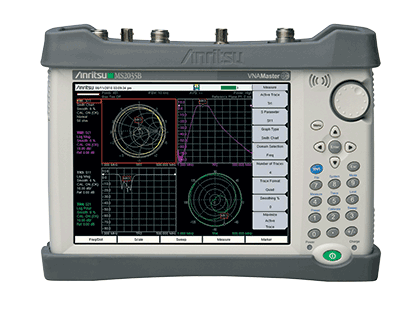Microwave Components and Device Characterization

Overview
As modern signaling standards push the limits beyond LTE into 5G, engineers are faced with verifying their complex, high-bandwidth designs under tighter time-to-market constraints. Whether it is for aerospace/military, commercial wireless, public safety, automotive, or IoT, the proper test solution can ensure the accurate and efficient verification and characterization of components for next-generation applications. Anritsu offers an advanced portfolio of comprehensive measurement tools for high-speed communications signals.
VNAs
Anritsu continues to be the leader in vector network analyzer (VNA) technologies for every measurement scenario. Our VNAs provide pulse measurements, S-parameters, and more data to ensure that devices can be used in designs as diverse as Bluetooth products, 4G/5G mobile phones, military electronic-warfare (EW), connected cars, radar systems, and more.
With industry leading frequency span from 70 kHz to 145 GHz, VectorStar offers a new performance benchmark for measuring RF, microwave, and millimeter wave devices. VectorStar is particularly well-suited for active device characterization and other R&D functions covering frequency ranges from 70 kHz to 70, 110, and 145 GHz. ShockLine VNAs are particularly well-suited for passive E-band product/component development. Both VNAs utilize Non-Linear Transmission Line technology samplers. ShockLine VNAs are simple, economic, high-performance instruments for testing cost-sensitive passive devices in engineering, manufacturing, and education.
Bluetooth Testers
As a Bluetooth Special Interest Group (SIG) member since 1999, Anritsu has actively participated in the development of the standard from Core Specification version 1.0. The Bluetooth Test Set MT8852B is the market-leading RF measuring instrument that supports Basic Rate (BR), Enhanced Data Rate (EDR) and Bluetooth low energy (BLE) measurement of transmit power, frequency, modulation, and receiver sensitivity required by Bluetooth RF test specifications to verify designs used in connected cars, smart homes, consumer devices, and other applications.
Power Meters
Anritsu’s family of USB and traditional power meters deliver the precise power measurements necessary for today’s high-speed devices. Our MA24200 series USB sensors provide accurate true-RMS power measurements of almost any signal across a wide dynamic range. The super fast measurement speeds make them perfect for any automated test procedure. For benchtop solutions, the ML2490 series is for narrow fast rising-edge pulse power measurements while the ML2480B conducts power measurements on signals such as LTE and WLAN. For CW applications, there are the MA24300A USB meters or ML2430A benchtop meter, offering a combination of accuracy, speed, and flexibility in a low-cost package.
Spectrum/Signal Analyzers
Anritsu spectrum/signal analyzers, such as the MS2840A, MS2830A and MS269xA series, have the excellent general level accuracy, dynamic range and performance of a high-end spectrum analyzer, making them flexible single-instruments solutions for Tx and Rx measurements. Their ability to capture wideband signals and integration of FFT technology supports multifunction signal analyses in both the time and frequency domains. This makes them well suited for cellular, Land Mobile Radio/Public Safety Radio and IoT/M2M communications. The MS2840Aand MS2830A can be integrated with the High Performance Waveguide Mixer MA2806A or MA2808A that enables spectrum measurements between 50 GHz and 75 GHz or between 60 GHz and 90 GHz. Connecting the high-performance waveguide mixer to the MS2840A and MS2830A support high dynamic range measurements, as well as eliminates image-response effects at wideband signal measurements, making it ideal for measuring mmWave wideband wireless equipment.
Signal Generators
Whether the design is for satellite communications or defense systems, Anritsu provides the best synthesized signal generators that offer engineers high-signal purity, low noise and excellent frequency stability. Instruments satisfy a full range of modulation capabilities for signal simulations from simple to the most complex, including Amplitude (AM), Frequency (FM), Phase (φ) and Pulse (PM).
近几年来,以太网以其简单易用和价格低廉的特点成为了主流数据传输技术。以太网最初是作为局域网 (LAN) 技术出现的,但是现在也用于端到端通信。同时,许多新协议 (如以太网 OAM、VLAN、PBB-TE 和 MPLS-TP) 也应运而生,将以太网从 LAN 技术迁移至电信级技术。
以太网 OAM (操作、管理和维护) 旨在简化复杂以太网网络的操作、管理和维护流程并降低运营成本。 以太网 OAM 支持链路故障管理、连通故障管理和性能监控; 已在 IEEE 802.3 (之前版本为 IEEE 802.3ah)、IEEE 802.1ag 和 ITU-T Y.1731 中进行了定义。
虚拟局域网 (VLAN) 已在 IEEE 802.1Q 中定义,它按照功能、项目团队或应用程序在组织基础上划分 LAN。在 IEEE 802.1ad 中定义的堆栈式 VLAN (Q-in-Q) 是在 VLAN 中承载的 VLAN。它允许服务提供商通过 VLAN 以透明方式传输客户 VLAN 流量。某些情况下,服务提供商和/或客户使用多个 VLAN 标签。
提供商骨干桥接 (PBB) - 流量工程 (PBB-TE) 旨在为电信级以太网提供确定的、面向连接的 TDM 功能。实现方式是同时使用 PBB (通常称为 MAC-in-MAC) 和 VLAN 技术来识别流量。管理系统使用点到点连接路径和 OAM 协议处理网络流量的路由。管理系统还可以创建备份路由,从而在必要时进行切换。
多协议标签交换 (MPLS) - 流量参数 (MPLS-TP) 扩展了 MPLS 协议集,旨在向 MPLS 网络提供确定的电信级服务。 传输参数允许封装无连接流量,使其成为面向连接的服务。MPLS-TP 创建标签交换路径 (LSP) 以通过网络传输流量,同时使用 OAM 信息,包括自动保护交换 (APS) 等信息。
Products

MA24330A
Microwave CW USB Power Sensor
10 MHz - 33 GHz frequency
K (male) connector

MA24340A
Microwave CW USB Power Sensor
10 MHz - 40 GHz frequency
K (male) connector

MA24350A
微波 CW USB 功率传感器
10 MHz — 50 GHz
50 kHz 视频带宽

MS2830A
9 kHz - 3.6 GHz, 6 GHz, 13.5 GHz

MG3690C
RF/Microwave Signal Generator
0.1 Hz - 70 GHz, 500 GHz freq
5 ms Switching Speed

MS46524B
ShockLine 4 port VNA
50 kHz - 8.5, 20, 43.5 GHz freq
140 dB max Dynamic Range

MS2713E
Handheld Spectrum Analyzer
9 kHz - 6 GHz frequency
1 Hz - 3 MHz resolution bandwidth

MS2034B
Handheld Vector Network Analyzer
500 kHz - 4 GHz VNA frequency
9 kHz - 4 GHz SPA frequency

MS2035B
Handheld Vector Network Analyzer
500 kHz - 6 GHz VNA frequency
9 kHz - 6 GHz SPA frequency

MS2036C
Handheld Vector Network Analyzer
5 kHz - 6 GHz VNA frequency
9 kHz - 9 GHz SPA frequency

MS2037C
Handheld Vector Network Analyzer
5 kHz - 15 GHz VNA frequency
9 kHz - 15 GHz SPA frequency

MS2038C
Handheld Vector Network Analyzer
5 kHz - 20 GHz VNA frequency
9 kHz - 20 GHz SPA frequency